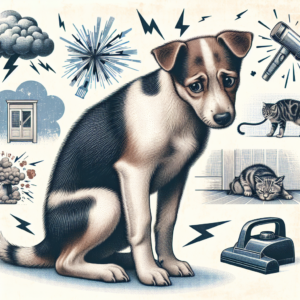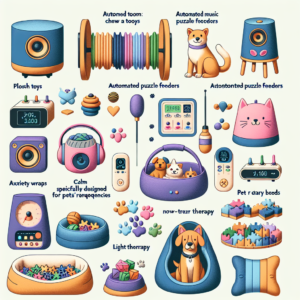- Key Takeaways
- What to Look for in Quality Pet Therapy Equipment
- Safety Standards and Certifications
- Benefits of Pet Therapy for Physical Rehabilitation
- Emotional and Behavioral Advantages of Pet Therapy
- Laser Therapy Devices for Pain Relief
- Supportive Harnesses and Mobility Aids
- Exercise Equipment for Animal Physiotherapy
- Calming and Massage Tools
- Creating a Routine with Your Therapy Devices
- Maintaining and Cleaning Your Pet Therapy Equipment
- Assessing Your Pet's Condition and Therapeutic Requirements
- How do I know if a therapy device is right for my pet?
- Can pet therapy devices be used on all animals?
- Are there any risks associated with using pet therapy devices?
- How often should therapy devices be used for maximum benefit?
- Where can I find reputable suppliers for safe pet therapy devices?

When it comes to caring for our furry friends, we all want what’s best for them. Whether they’re recovering from surgery, dealing with chronic pain, or simply aging gracefully, pet therapy equipment can be a game-changer. It’s all about enhancing their quality of life and providing relief where it’s needed most. But with so many options on the market, it’s crucial to choose safe and effective devices that cater to the unique needs of our pets.
Key Takeaways
- Identify the right pet therapy equipment by considering safety, effectiveness, and suitability for your pet’s condition.
- Ensure any therapy device you choose meets established safety standards and certifications.
- Understand how therapy devices can aid in both physical rehabilitation and emotional well-being of pets.
- Learn about the various types of safe pet therapy devices, including laser therapy, mobility aids, and massage tools.
- Discover the importance of integrating therapy devices into your pet’s routine and maintaining them properly.
Choosing Safe and Effective Pet Therapy Devices
Choosing the right therapy equipment for your pet is not just about comfort; it’s about their safety and your peace of mind. You’ll want to look for devices that are designed with pets in mind, taking into account their size, mobility level, and specific health needs. Quality equipment should be made from non-toxic materials, be easy to clean, and designed to prevent any additional injury or discomfort to your pet.
What to Look for in Quality Pet Therapy Equipment
When selecting therapy equipment for your pet, here are some key factors to consider:
- **Material Quality**: Opt for materials that are durable, non-irritating to your pet’s skin, and easy to clean.
- **Design and Comfort**: Choose devices that are ergonomically designed to fit your pet’s body without restricting movement.
- **Adjustability**: Look for equipment that can be adjusted to ensure a proper fit, which is crucial for safety and effectiveness.
- **Ease of Use**: You should be able to easily use the device on your pet without causing them stress or discomfort.
- **Manufacturer Reputation**: Research the brand and read reviews to ensure they have a good track record for safety and customer satisfaction.
Safety Standards and Certifications
Safety should always be your top priority. Make sure any therapy device you consider is compliant with relevant safety standards and holds certifications from recognized industry bodies. This not only ensures the device has been tested for safety but also that it’s likely to be effective in providing therapeutic benefits to your pet.
The Role of Pet Therapy Devices in Improving Pet Well-being
Pet therapy devices play a significant role in the overall well-being of our pets. They provide relief from pain, support recovery from injuries, and can even help manage chronic conditions. But it’s not just about physical health; these devices also offer emotional and behavioral benefits that can lead to a happier, more relaxed pet.
Benefits of Pet Therapy for Physical Rehabilitation
Physical rehabilitation for pets can greatly benefit from the use of therapy devices. Here’s how:
- **Pain Management**: Devices like therapy lasers can help reduce pain and inflammation, making recovery more comfortable for your pet.
- **Improved Mobility**: Support harnesses and wheelchairs can assist pets with mobility issues, allowing them to move more freely and maintain muscle tone.
- **Faster Recovery**: Regular use of therapy equipment can speed up the healing process by encouraging blood flow and tissue repair.
Remember, each pet is unique, and what works for one may not be suitable for another. Always tailor the therapy to your pet’s specific needs.
Emotional and Behavioral Advantages of Pet Therapy
Besides physical health, pet therapy devices can also nurture your pet’s emotional well-being. For instance, massage tools can reduce anxiety and stress, leading to a calmer demeanor. Consistent use of these devices can also improve the bond between you and your pet, as they come to associate the therapy sessions with positive experiences and attention from their favorite human.
Top Safe Use Pet Therapy Devices
Let’s delve into some of the most trusted and safe therapy devices that can make a difference in your pet’s life.
Laser therapy devices are a popular choice for pain relief and healing. They work by emitting a concentrated light that penetrates the skin to promote healing at the cellular level. It’s a non-invasive method that can be particularly helpful for conditions like arthritis, wounds, or post-surgery recovery.
But, as with any therapy device, it’s essential to use it correctly. Always follow the manufacturer’s guidelines and consult with your vet before starting any new treatment. Here’s what you should know about laser therapy devices:
Example: The XYZ Laser Therapy Device is designed for ease of use at home, with adjustable settings to cater to your pet’s specific needs. It’s lightweight, portable, and comes with safety features like a timer to prevent overuse.
Supportive harnesses and mobility aids are also vital for pets with physical limitations. They can help your pet move around without putting too much strain on their body, which is essential for healing and maintaining muscle mass.
As for exercise equipment, it’s not just about keeping your pet fit. It’s also about ensuring they’re able to move in ways that support their therapy. For example, treadmills designed for pets can help with gait training and building endurance, especially when outdoor walking isn’t possible.
And let’s not forget about calming and massage tools. These can range from simple items like soft brushes to more sophisticated massaging devices. They serve to relax your pet, which is especially important for those who may be experiencing anxiety or stress due to health issues.

In the next part of the article, we’ll explore how to integrate these devices into your pet’s daily routine and the importance of maintaining them for long-term use.
Laser Therapy Devices for Pain Relief
Laser therapy devices are a cornerstone in the field of pet therapy, offering a non-invasive solution to pain management. These devices use low-level lasers to stimulate cell regeneration and increase blood circulation, effectively aiding in the healing process for a variety of conditions. For pets suffering from ailments such as arthritis, muscle strains, or post-surgery pain, laser therapy can provide a much-needed respite from discomfort.
Most importantly, when using laser therapy devices, it’s essential to adhere to a prescribed schedule. Overexposure can lead to complications, so it’s crucial to follow the guidelines set by your vet or the device manufacturer. Some devices come with built-in timers and safety locks to prevent misuse, ensuring your pet’s therapy session is both effective and safe.

Supportive Harnesses and Mobility Aids
For pets with mobility issues, supportive harnesses and mobility aids can be life-changing. These devices allow pets to move around more freely, which is vital for their physical health and mental well-being. Supportive harnesses can assist pets with weak hind legs, while wheelchairs or carts are available for those with more severe mobility challenges.
When selecting a harness or
mobility aid, look for features like adjustable straps, comfortable padding, and breathable materials. The right fit is crucial to prevent any additional strain on your pet’s body. It’s also important to introduce these aids gradually, allowing your pet to get accustomed to their new support system.

Exercise Equipment for Animal Physiotherapy
Exercise equipment tailored for
animal physiotherapy can help maintain your pet’s fitness levels, especially if they’re recovering from an injury or surgery. Treadmills, balance balls, and resistance bands are all excellent tools that can be incorporated into a rehabilitation program. They not only assist with building muscle and improving coordination but can also be a fun way for your pet to engage in physical activity.
When using this equipment, always supervise your pet to ensure they’re using it correctly and safely. Start with short sessions and gradually increase the duration and intensity based on your pet’s endurance and the advice of a rehabilitation specialist.

Calming and Massage Tools
Calming and massage tools play a crucial role in a pet’s therapy routine, particularly for those who experience anxiety or stress. These tools can range from soft brushes for gentle strokes to specially designed pet massagers that provide a deeper muscle relaxation. Regular use can help soothe your pet, reducing stress and potentially improving their response to physical therapy.
It’s important to observe your pet’s reaction to these tools and adjust the pressure or technique accordingly. Some pets may prefer a lighter touch, while others might benefit from a more vigorous massage. Always ensure that the experience is a positive one for your pet.

Integrating Pet Therapy Equipment Into Daily Care
Integrating pet therapy equipment into your pet’s daily routine can maximize the therapeutic benefits and help maintain their overall health. Establishing a routine helps your pet become comfortable with the therapy process and can even be something they look forward to each day.
Creating a Routine with Your Therapy Devices
To create a successful routine with your therapy devices, consistency is key. Start by setting a regular time each day for therapy sessions, keeping in mind your pet’s energy levels and mood. Ensure the environment is calm and comfortable, free from distractions that could cause stress or impede the therapy’s effectiveness.
For example, you might decide to use a massage tool every evening before bed to help your pet relax. If you’re using a treadmill for physiotherapy, choose a time of day when your pet is typically more active and receptive to exercise. The goal is to make therapy a positive and predictable part of their day.
Maintaining and Cleaning Your Pet Therapy Equipment
Maintaining and cleaning your pet therapy equipment is vital for ensuring its longevity and your pet’s safety. Always follow the manufacturer’s instructions for cleaning and storage. For items like harnesses and mobility aids, regularly check for signs of wear and tear, and make any necessary adjustments to maintain a proper fit.
Hygiene is especially important for items that come into direct contact with your pet’s skin or wounds. For example, laser therapy devices should be wiped down with a disinfectant after each use to prevent any risk of infection.
How to Identify Your Pet’s Needs for Therapy Tools
Not all pets will require the same therapy tools. Identifying your pet’s specific needs is crucial to selecting the right equipment and ensuring their comfort and safety during therapy sessions.
Assessing Your Pet’s Condition and Therapeutic Requirements
To assess your pet’s condition and therapeutic requirements, start by observing their daily behavior and mobility. Are they showing signs of discomfort when moving? Do they have trouble standing up after lying down? These observations can provide valuable insights into the type of support they might need.
Consulting with a veterinarian or a certified animal rehabilitation therapist is essential. They can perform a thorough examination and recommend the appropriate therapy devices. They might also provide guidance on how to use the equipment effectively and safely.
In conclusion, selecting the right pet therapy equipment is a careful balance of understanding your pet’s needs, ensuring the quality and safety of the devices, and integrating them into a routine that supports your pet’s health and happiness. With the right approach, these tools can significantly enhance your pet’s quality of life.
Frequently Asked Questions
- How do I know if a therapy device is right for my pet?
- Can pet therapy devices be used on all animals?
- Are there any risks associated with using pet therapy devices?
- How often should therapy devices be used for maximum benefit?
- Where can I find reputable suppliers for safe pet therapy devices?
How do I know if a therapy device is right for my pet?
Choosing the right therapy device for your pet involves a few steps. Start by observing any physical or behavioral changes in your pet that might suggest a need for therapy. Next, consult with your veterinarian or a professional pet therapist who can provide a diagnosis and recommend specific therapy equipment. It’s also essential to consider the size, breed, and particular condition of your pet to ensure the device is appropriate and safe for their use.
Can pet therapy devices be used on all animals?
While many pet therapy devices are versatile, not all are suitable for every type of animal. Devices are often designed with specific species, sizes, and conditions in mind. For instance, a therapy harness designed for a medium-sized dog may not be appropriate for a small rabbit. Always check the manufacturer’s specifications to ensure the device is safe for your particular pet.
Are there any risks associated with using pet therapy devices?
Yes, there can be risks if therapy devices are used improperly. It’s crucial to follow the instructions provided by the manufacturer and to consult with your vet. Overuse or incorrect use can lead to further injury or discomfort. Additionally, always supervise your pet during therapy sessions to quickly address any issues that may arise.
How often should therapy devices be used for maximum benefit?
The frequency of use for pet therapy devices will vary depending on the device and your pet’s condition. Some devices, like massagers, can be used daily, while others, like laser therapy equipment, may require a schedule that includes rest days. Always follow a vet-approved plan that’s tailored to your pet’s specific needs for the best results.
For example, a common schedule for laser therapy might be three times a week for acute conditions, with adjustments made as your pet’s condition improves.
Where can I find reputable suppliers for safe pet therapy devices?
Finding reputable suppliers for pet therapy devices involves a bit of research. Look for suppliers that offer detailed product information, customer support, and warranties. Reading reviews and asking for recommendations from your veterinarian or pet therapy professionals can also lead you to trusted suppliers. Online marketplaces with verified reviews can be a good starting point, but always verify the legitimacy of the products and sellers.



Leave a Reply